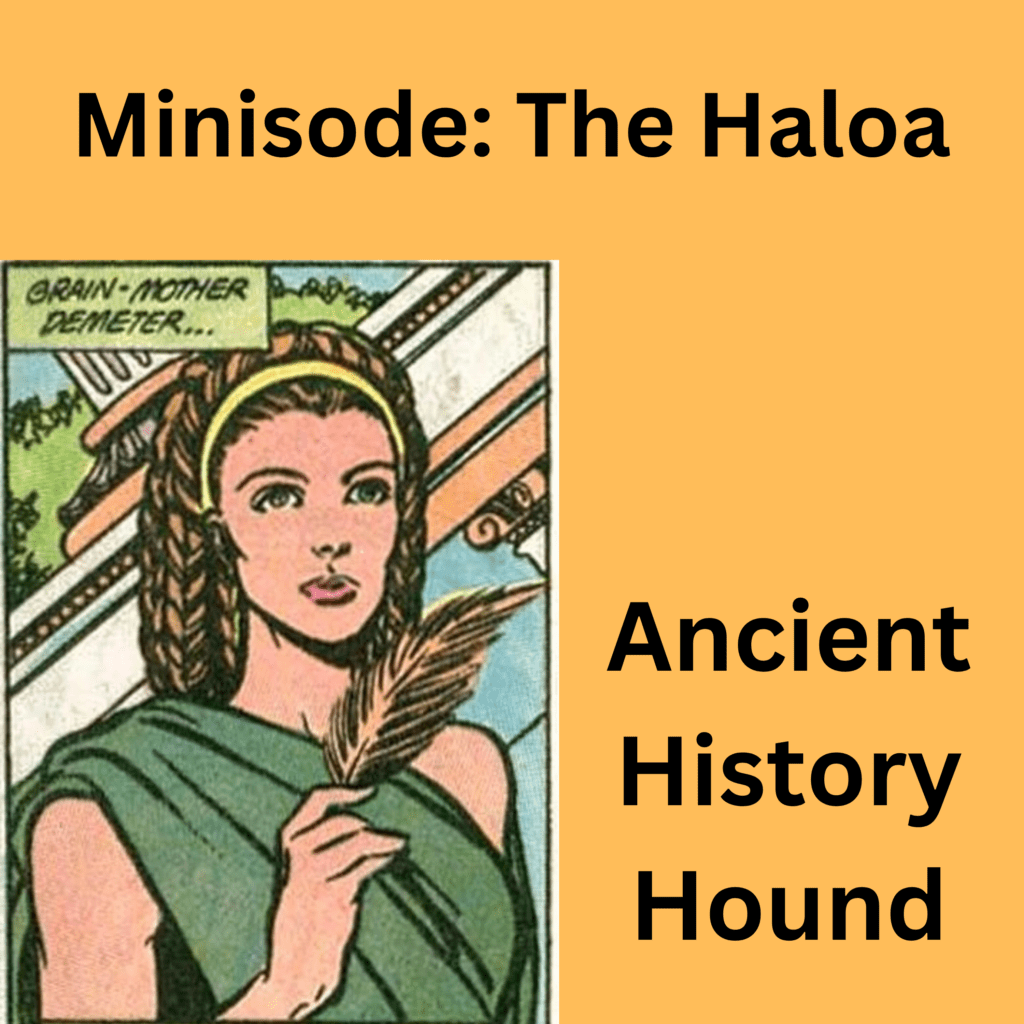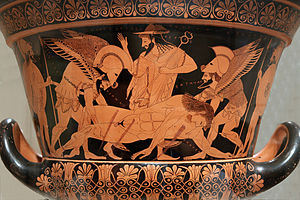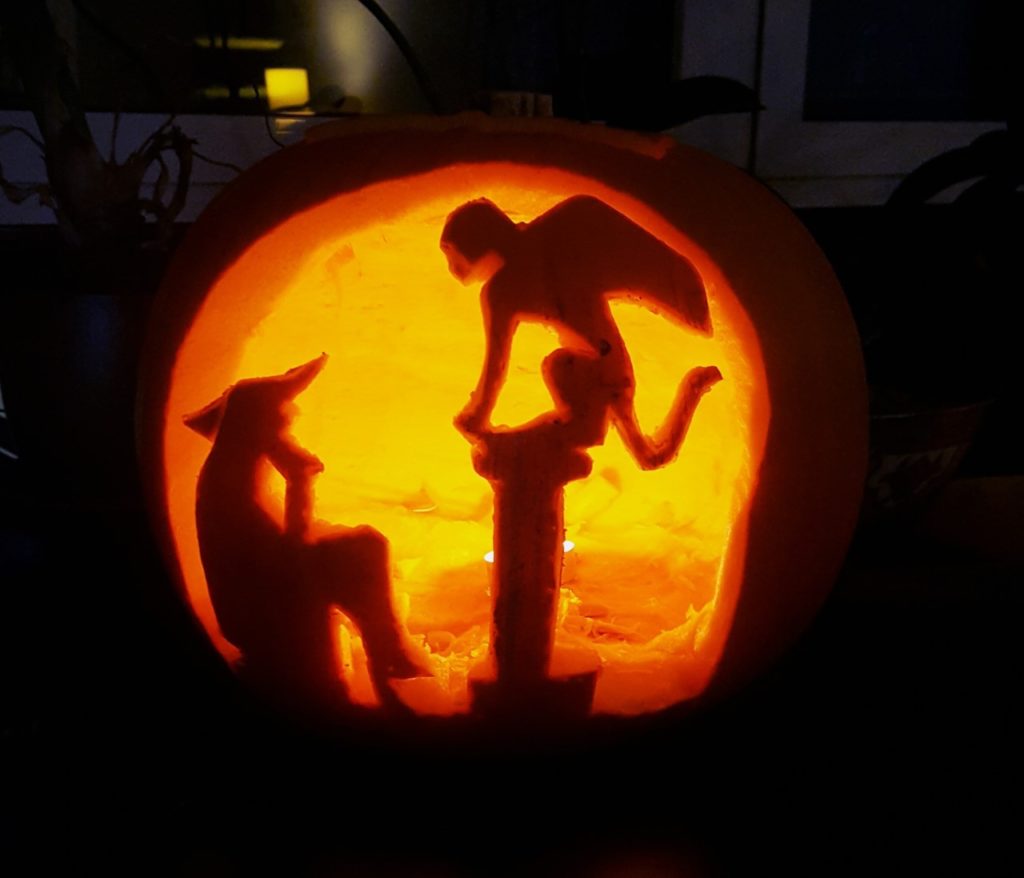Haloa – some notes.
First of all – if you haven’t listened to the episode on the Haloa then here’s my podcast (you can find it on most platforms). I hope you enjoyed it, it would certainly be on my to-do list if I ever have a time machine and a good disguise.
Eleusis.
Here’s a plan what Eleusis may have looked like.
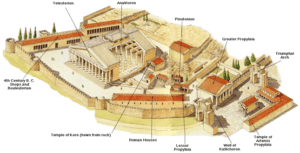
As you can see the Telesterion was a main building and the use of it as an indoor venue must at least have been an option.
Here’s a model which gives another view, this is where the Sacred Way from Athens ended. Speaking of which here’s a map of Athens, Eleusis and that very road.
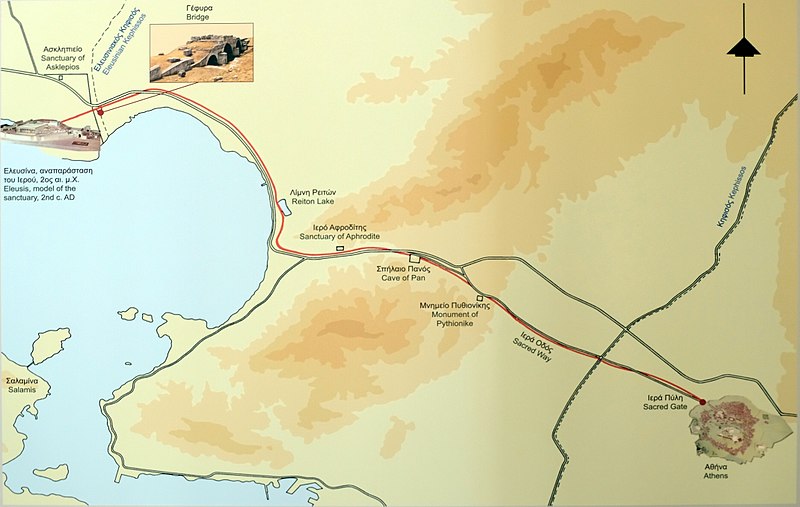
If you are more interested about the Telesterion there’s a great website called Anasynthesis which has some 3D reconstructions which give much more perspective. One example is the image below of the possible venue with the roof off.

Vase Images.
The first image is pelike dating to circa 440 BC. It looks as if a woman is sprinkling a number of phalli and it’s thought that this relates to the type of agricultural festival women were involved with. Perhaps the image is a bit tongue in cheek.

The second image is a little more substantial. Two hetaera dance around a large phallus (circa 500-450 BC) this has again been linked with the Haloa festival.
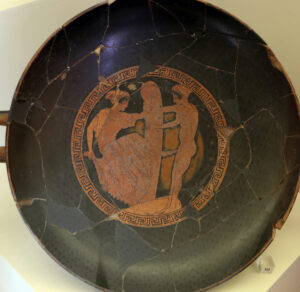
Reading list.
Alciphron, Letters of the Courtesans.
Brumfield, A. The Attic Festivals of Demeter and Their Relation to the Agricultural Year
Aporetta: Verbal and Ritual Obscenity in the Cults of Ancient Women.
Håland, E. Greek Festivals, Modern and Ancient. Vol 1.
Georgopoulos, Vagenakis, Pierris. Baubo: a Case of Ambiguous Genitalia in the Elusinian Mysteries.
Robertson, N. New Light on Demeter’s Mysteries: The Festival Proerosia.
Poseidon’s Festival at the Winter Solstice.
Transcript.
The Ancient Greeks didn’t have Christmas, but they did have a festival where bad behaviour, drunkenness and obscene language was actively encouraged. Throw in a cheeseboard and an argument over a board game and that’s pretty much my experience of Boxing Day. Join me as I talk about the Haloa on the Ancient History Hound Podcast.
Hi and thanks for joining. My name’s Neil and if this podcast title feels a bit familiar then yes, this is an updated version of an episode I recorded back in 2018. Having recently listened back to it recently there was enough I could change and update that I thought it was worth just doing that. Of course there’s a strong chance you’ve not heard this one before in which case ignore everything I just said.
As ever you can find me on my website – ancientblogger.com. I’m ancientblogger on twitter, instagram and tiktok, Youtube as well. The podcast is also on twitter as @HoundAncient so come say hi. I’ll be including a set of episode notes for this on ancientblogger.com with more about Eleusis, a transcript of the epsiode a reading list as well as a couple of other images.
Ok then, on we go.
Around 11 miles northwest of Athens lies the famed sanctuary of Demeter at Eleusis, it was a hugely important place and famous for hosting the Eleusinian Mysteries. This was a secret religious initiation which was held each year in the atumumn. As you might expect the main deity involved here was Demeter alongside her daughter Persephone.
It was here that the Haloa was celebrated. This was a festival held in the Attic month of Poseidon, yes, he had a month named after him. But to be clear this was the Attic calendar, which related to Athens and Attica, the region around it which Athens controlled. There was no universal standard calendar in ancient Greece and other regions had their own calendars. But we know that the month of Poseidon tracked roughly with December and January. There’s even a specific date given for it, the 26th, which has been suggested but it’s quite tricky to align calendars. The Attic calendar was synched to the new moon, which changes. So if it was late in the month then it could be anywhere from late December through to early January on our calendar. And in a way it’s not that important. What is important though is that this festival took place in the depths of winter and this, as you’ll hear, was why it happened at all.
Another key ingredient was the goddess Demeter as it was a festival in honour of her. As you might know Demeter was the goddess of agriculture and this was a crucial element of life, in fact in many ways it was life. A town or city could only be as important as the agriculture which supported it and in the modern world we can easily forget this link. A bad or good harvest was literal life or death.
The Haloa was a festival specifically linked to Demeter as you’ll hear and to a specific incident in her myth. This is an old one, much of the detail is held in the Homeric Hymn to Demeter which dates to the 7th or 6th centuries BC. To understand the Haloa we need to understand the associated myth of Demeter and the specific incident I mentioned.
I’ll start with the abduction of Persephone, something you’ve probably heard about. She was Demeter’s daughter and she was abducted by Hades and that meant she was taken to the Underworld. When Demeter found out she went into a sort of exile, she travelled to Eleusis and assumed the form of an old woman. It was here she sat by a well and was spotted by some noble women who took her to the palace at Eleusis. Here the goddess, still in disguise, sat on a stool despondent. However, a woman called Iambe approached her and made some jokes. These worked and Demeter was cheered up, albeit temporarily.
Well, that’s one version.
In a later version Iambe was replaced by a character called Baubo and instead of jokes Baubo just flashed herself at the goddess which got the same reaction, laughter. Baubo is present elsewhere in Greek culture and often linked to female genitalia. This feels like an extreme contrast, one one hand you have jokes on one hand and the other, well, indecent exposure. However, it’s not much of a contrast if those jokes were indecent as Diodorus Siculus, a historian of the 1st century BC noted. The consensus was then that Iambe got the reaction she did from some very riske material.
Bad language aside something else which does track from the incident to the festival was that it was an all woman affair. This wasn’t unusual, the Thesmophoria was a big festival for Demeter and also permitted only women. Where the Haloa may have been different was that it was open to women from all backgrounds and this included hetarae, or prostitutes. All of these women mixed during an all night feast of partying, drinking and bad language and I’ll get to that in a moment.
Before that I’ll try and build a sequence of events and flesh out what happened. The festival kicked off with a sacrifice overseen by a priestess, not a priest and this is in fact referenced in a speech by the 4th century orator and all-round Macedonian nemesis Demosthenes. He referenced an individual called Archias who was punished for two things, the first sacrificing to Demeter on the day of the festival with the wrong kind of offering and the second, being a man who was doing the sacrificing.
The likely location for the sacrifice was a building called the eschara and it’s probable that this took place in the middle of the afternoon. I make this assumption based on how long it might take the women to assemble at the sanctuary. Presumably they would have travelled from across Attica but it’s likely many would have come from Athens or via it. This would have made sense, Athens was linked to Eleusis via a road called the Sacred Way. This was used mainly for a procession to it during the Eleusinian Mysteries but was presumably used at other times to get there. The Sacred Way measured 22km or 13 miles and that might take anywhere between 3 and 5 hours to get there depending on how fit or able you were to make that journey.
By the time many of the women got to Eleusis it could be early afternoon. But they then needed to be marshalled and get into place for the sacrifice which would have involved offerings such as agricultural produce and cakes, it didn’t involve animals. Having the sacrifice around this time would also allow the next stage to be thoroughly prepared for. This was the pannychis, the all night feast and you wouldn’t everyone waiting around too long. It would be dark soon so the women needed to get to where this was most likely held, a building in the sanctuary called the Telesterion.
This was a large hall which was colonnaded, meaning that there were columns inside it, 42 in fact and they supported the roof. The Telesterion measured approximately 52 by 54 metres. This building had seen many phases of construction, and by the mid 5th century BC had eight rows of steps, cut from rock on each side. Perhaps there was additional seating because one estimate has the Telesterion as a venue supporting 3,000 people. That’s not saying this was how many women attended, there’s no real way of knowing but it’s worth knowing just to give a cap.
It’s here that things started to escalate. Amongst the wine and food women were encouraged to use rude and course language, perhaps tell the odd vulgar joke. All this whilst nibbling on a pastry shaped in the form of male of female genitalia. Yes, they had those as well. Perhaps this was why the hetaerae were allowed to mix, the idea being that thematically they aligned well with this. We even have a record of two hetaerae falling out at the Haloa, well, in a way we do. The account of the dispute comes in the form of a series of letters written by Alicphron. These were presumably fictional letters, perhaps inspired by real instances but not written by hetaerae unfortunately – that would be incredible on so many levels. We know very little about Alicphron so we can’t even date him.
The letter in question gave an account of a falling out between Euxippe and Thais, the letter apparently written by the latter to a friend. It started when Euxippe mocked Thais for losing a lover and then started on her hair and makeup. In the letter Thais commented to her friend that Euxippe must have been on hard times as she presumably couldn’t afford a mirror, given the state of her own makeup.
By now you may have worked out the rationale for all this shameful talk, rude jokes and that kind of thing. Namely the link to that incident with Demeter and the rude jokes. This type of language had a specific name, aporetta and it wasn’t just found at the Haloa.
At the Stenia and Thesmophoria, festivals held earlier in the year, women engaged in what has been called ritual obscenity (or aporetta). Both these festivals were in observance to Demeter and linked to the sowing or ploughing of the fields. It wasn’t all based in Attica though, in Arcadia Demeter had a festival which included both men and women. On the 3rd day men left, in fact anything male, even dogs were made to leave. The women had their own mysteries overnight and when the men returned the two groups mocked and jeered each other, presumably using bad language. At Epidaurus two choruses of women abused each other at a festival for Damia and Auxesia, local variants of Demeter and Persephone.
So why the need for aporetta exactly? Well it’s argued that aporetta had a function of encouraging agricultural fertility. Where aporetta had cajouled a despondent Demeter into laughter so too the fields in the depths of winter could be roused into action and this would ensure the crops grew during this time. It’s important to note that this point in the year was pivtoal for agriculture. Crops had been sown and growth was underway. If the crops didn’t continue growing properly at this point the knock on effect could be a poor harvest in the spring.
The idea of rousing the fields to action in deep midwinter can be seen in another important element of the Haloa. Fire. The accounts of the sanctuary for the year 329/8 BC recorded that 67 talents weight of firewood was needed for the festival. One estimate puts this at 5,360 lbs or 2,431 kg of firewood.There’s been a bit of speculation about what this was used for as you might imagine, most likely though is for fires and perhaps a bonfire.
How the Haloa got its name has been debated, it can be translated as threshing floor which was where wheat was separated from the chaff. But this would have been done months earlier. Perhaps the sacred threshing floor was where a large bonfire was built? Alternatively perhaps this was where dances were held. There are references to the contest at the Haloa, presumably anything in the dark and involving very drunk individuals rules out the more traditional sporting contests. So why not dancing or choruses? It would have been cold and dark so what better way to keep the feast going throughout the night than a big fire with other fires nearby and dancing and singing.
The light and heat as well as being practical can be seen as further way to invigorate the fields and urge good growth. Though we don’t have much information about the Haloa it seems to link in with other festivals associated with Demeter and women which relate to agricultural fertility. There was the Thesmophoria which was celebrated at the time of sowing the fields as I mentiined earlier. If we think of the two working together then we have the Haloa at the crucial time and working to ensure that the crops grew and the harvest was good.
It must also have had a really positive effect on those participating. Hangovers aside it allowed the women there some licence to dance, drink and talk. Perhaps even make new friends or learn a new shocking joke or two. And moving to the modern day if this gives you a few ideas of how to freshen up Boxing day or just do something completely different who am I to argue? You can mark it down as cultural.
And that brings me to the end of this minisode on the Haloa. I hope you have enjoyed it and if you want to get in touch with me come say hi. If you want to email me you can do that as well at ancientblogger@hotmail.com

